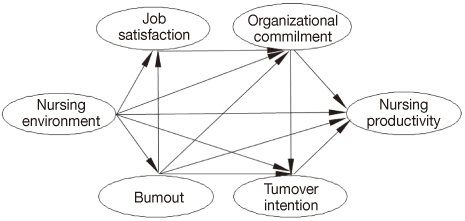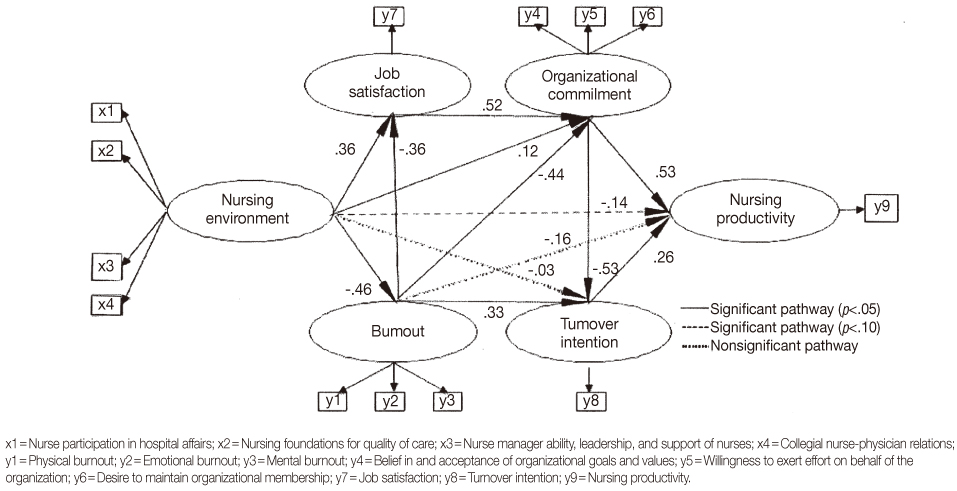J Korean Acad Nurs.
2013 Feb;43(1):20-29. 10.4040/jkan.2013.43.1.20.
Structural Equation Modeling on Nursing Productivity of Nurses in Korea
- Affiliations
-
- 1College of Nursing, Eulji University, Daejeon, Korea.
- 2Department of Nursing, Chungbuk National University, Cheongju, Korea. kyung11@chungbuk.ac.kr
- 3Appenzeller School of Public Administration, Paichai University, Daejeon, Korea.
- 4Nursing Department, Eulji University Hospital, Daejeon, Korea.
- 5Department of Nursing, Sunchon National University, College of Life Science and Natural Resources, Sunchon, Korea.
- 6The Research Institute of Nursing Science, Seoul National University, Seoul, Korea.
- KMID: 1732662
- DOI: http://doi.org/10.4040/jkan.2013.43.1.20
Abstract
- PURPOSE
The purpose of this study was to propose and test a predictive model that could explain and predict nursing productivity.
METHODS
A survey using a structured questionnaire was conducted with 360 nurses in Korea. The data were analyzed using SPSS Windows 18.0 and AMOS 19.0 program.
RESULTS
Based on the constructed model, burnout and organizational commitment were found to have direct effects on nurses' turnover intention and nursing productivity. While nursing work environment was found to have indirect effects on nurses' turnover intention and nursing productivity.
CONCLUSION
This structural equational model is a comprehensive theoretical model that explains the related factors and their relationship with nursing productivity. Comprehensive organizational interventions to improve nursing productivity should focus on improving the nursing work environment. Findings from this study can be used to design appropriate strategies to decrease nurse turnover in Korea. Further studies are needed to prospectively verify these causal relationships with larger samples.
MeSH Terms
Figure
Cited by 2 articles
-
Influence of Emotional Intelligence, Communication, and Organizational Commitment on Nursing Productivity among Korean Nurses
Hyo Geun Geun, Eunok Park
J Korean Acad Community Health Nurs. 2019;30(2):226-233. doi: 10.12799/jkachn.2019.30.2.226.Literature Review of Structural Equation Models for Hospital Nurses' Turnover Intention in Korea
Eunhye Kim, Jinhyun Kim
Perspect Nurs Sci. 2014;11(2):109-122. doi: 10.16952/pns.2014.11.2.109.
Reference
-
1. Aiken LH, Clarke SP, Sloane DM, Lake ET, Cheney T. Effects of hospital care environment on patient mortality and nurse outcomes. J Nurs Adm. 2008. 38(5):223–229. http://dx.doi.org/10.1097/01.NNA.0000312773.42352.d7.2. Aiken LH, Clarke SP, Sloane DM, Sochalski J, Silber JH. Hospital nurse staffing and patient mortality, nurse burnout, and job dissatisfaction. JAMA. 2002. 288(16):1987–1993. http://dx.doi.org/10.1001/jama.288.16.1987.3. Baernholdt M, Mark BA. The nurse work environment, job satisfaction and turnover rates in rural and urban nursing units. J Nurs Manag. 2009. 17(8):994–1001. http://dx.doi.org/10.1111/j.1365-2834.2009.01027.x.4. Bain DL. The productivity prescription: the manager's guide to improving productivity and profits. 1982. New York: McGraw-Hill.5. Cho E, Choi M, Kim EY, Yoo IY, Lee NJ. Construct validity and reliability of the Korean version of the practice environment scale of nursing work index for Korean nurses. J Korean Acad Nurs. 2011. 41(3):325–332. http://dx.doi.org/10.4040/jkan.2011.41.3.325.6. Coomber B, Barriball KL. Impact of job satisfaction components on intent to leave and turnover for hospital-based nurses: A review of the research literature. Int J Nurs Stud. 2007. 44(2):297–314. http://dx.doi.org/10.1016/j.ijnurstu.2006.02.004.7. Eaton-Spiva L, Buitrago P, Trotter L, Macy A, Lariscy M, Johnson D. Assessing and redesigning the nursing practice environment. J Nurs Adm. 2010. 40(1):36–42. http://dx.doi.org/10.1097/NNA.0b013e3181c47d04.8. Ha NS, Choi J. The relationship among leadership styles of nurse managers, job satisfaction, organizational commitment, andturnover intention. J Korean Acad Nurs. 2002. 32(6):812–822.9. Ha NS, Park HM. The effects of perception of internal marketing on performance of nursing organization. Clin Nurs Res. 2007. 13(2):7–16.10. Hair JF, Black B, Babin B, Anderson RE, Tatham RL. Multivariate data analysis. 2006. 6th ed. New York: Prentice Hall.11. Ingersoll GL, Olsan T, Drew-Cates J, DeVinney BC, Davies J. Nurses' job satisfaction, organizational commitment, and career intent. J Nurs Adm. 2002. 32(5):250–263. http://dx.doi.org/10.1097/00005110-200205000-00005.12. Jeong JH. Structural equation modeling on nursing productivity of nurses in a hospital. 2008. Seoul: Chung-Ang University;Unpublished doctoral dissertation.13. Jeong YM, Kang YS. The effect of job stress and burnout by job environment of care-givers on job satisfaction. J Korea Acad Ind Coop Soc. 2010. 11(10):3688–3699. http://dx.doi.org/10.5762/KAIS.2010.11.10.3688.14. June KJ, Byun SW. Nurse's burnout research throughout the past 10 years in Korea. J Korean Acad Nurs Adm. 2009. 15(3):305–313.15. Kim HK, Ji HS, Ryu EK, Lee HJ, Yun SE, Jeon MK, et al. Factors influencing on burnout of the nurses in hospitals. Clin Nurs Res. 2005. 10(2):7–18.16. Kramer M, Schalenberg C. Essentials of a magnetic work environment, part 1. Nursing. 2004. 34(6):50–54.17. Lake ET. Development of the practice environment scale of the Nursing Work Index. Res Nurs Health. 2002. 25(3):176–188. http://dx.doi.org/10.1002/nur.10032.18. Lee HJ. Predictors of job performance, work satisfaction, and productivity among Korean hospital nurses. J Korean Acad Nurs Adm. 2001. 31(4):571–583.19. Lee MH. Relationship between organizational culture types and organizational effectiveness in hospitals. 1998. Daejeon: Chungnam National University;Unpublished doctoral dissertation.20. Lee YJ, Kim KB. Experiences of nurse turnover. J Korean Acad Nurs. 2008. 38(2):248–257. http://dx.doi.org/10.4040/jkan.2008.38.2.248.21. McNeese-Smith D. Job satisfaction, productivity, and organizational commitment. The result of leadership. J Nurs Adm. 1995. 25(9):17–26. http://dx.doi.org/10.1097/00005110-199509000-00006.22. McNeese-Smith DK. A nursing shortage: Building organizational commitment among nurses. J Healthc Manag. 2001. 46(3):173–186.23. Moody RC. Nurse productivity measures for the 21st century. Health Care Manage Rev. 2004. 29(2):98–106. http://dx.doi.org/10.1097/00004010-200404000-00003.24. Moon SJ, Han SS. A predictive model on turnover intentionof nurses in Korea. J Korean Acad Nurs. 2011. 41(5):633–641. http://dx.doi.org/10.4040/jkan.2011.41.5.633.25. Oh YH, Jo JG, Kim JH, Ji YG. Mid-to long-term supply and demand projection of healthcare workforce. 2010. Seoul: National Health Personnel Licensing Examination Board.26. Park GJ, Kim YN. Factors influencing organizational commitment among hospital nurses. J Korean Acad Nurs Adm. 2010. 16(3):250–258.27. Park HS. Relationship between perceived nursing care role orientation, job characteristics, and turnover among nurses. 2002. Yonsei University: Seoul;Unpublished master's thesis.28. Park JS, Park BN. The influence of empowerment on job satisfaction, task performance and turnover intention by hospital nurses. J Korean Acad Nurs Adm. 2008. 14(2):150–158.29. Park KO. A study of variables related to nursing productivity. J Nurs Acad Soc. 1994. 24(4):584–596.30. Peltier J, Nill A, Schibrowsky JA. Internal marketing, nurse loyalty and relationship marketing: An exploratory study of German nurses. Health Mark Q. 2003. 20(4):63–82. http://dx.doi.org/10.1300/J026v20n04_05.31. Shields MA, Ward M. Improving nurse retention in the National Health Service in England: The impact of job satisfaction on intentions to quit. J Health Econ. 2001. 20(5):677–701. http://dx.doi.org/10.1016/S0167-6296(01)00092-3.
- Full Text Links
- Actions
-
Cited
- CITED
-
- Close
- Share
- Similar articles
-
- Structural Equation Modeling of Nurses’ Experience of Workplace Incivility
- Structural Equation Modeling on Burnout in Clinical Nurses based on CS-CF Model
- Structural Equation Modeling of Advanced Beginner-Stage Nurses' Intention to Continue Employment
- Influence of Emotional Intelligence, Communication, and Organizational Commitment on Nursing Productivity among Korean Nurses
- StructuralEquation Model of End-of-Life Nursing Performance of Home Visiting Nurses



